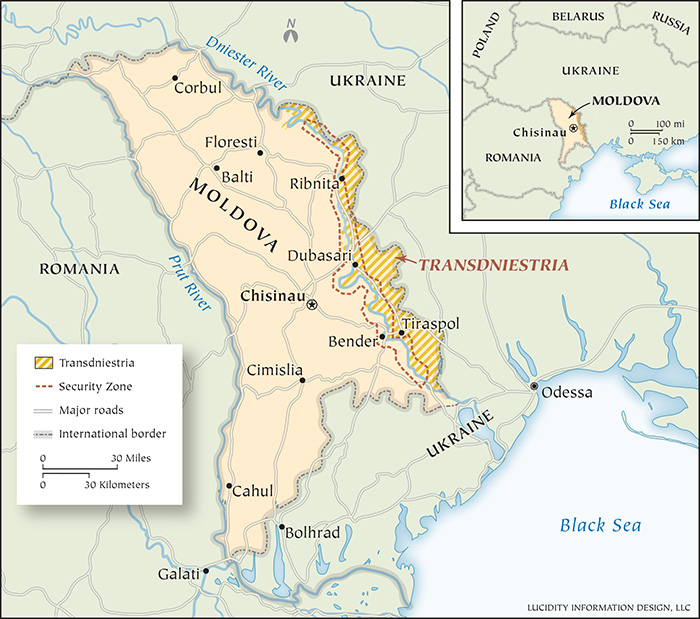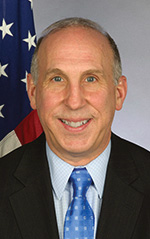Moldova—Putin’s Next Target?
A former ambassador to Moldova offers his perspective on the underlying issues of culture, language, ethnicity and history driving the current conflict.
BY JAMES PETTIT

Lucidity Information Design
As I write this article, we are seeing increased focus on a possible expansion of Russian aggression in Ukraine into the neighboring country of Moldova. Just recently, Russian General Rustam Minnekayev suggested that successful seizure of the entirety of Ukraine’s Black Sea coastal regions would allow access to the Russian-occupied breakaway section of eastern Moldova known as Transnistria (or Transdniestria).
Moldova is neither in NATO nor the European Union and would appear to be extremely vulnerable to a Russian invasion. It is a small country, relatively poor in human and material resources, and its military and tiny population (thousands already have immigrated to the West) would offer little effective resistance to a determined Russian advance. The result of an advance would put Russian forces face to face with Romania, a NATO country with strong historical and cultural ties to Moldova.
I am among those who believe that Russian President Vladimir Putin’s overarching goal is restoration of the Russian Empire and consolidation of a cultural myth known as the Russkiy Mir—a unique Russian space consisting of land and peoples who allegedly are an inseparable constituent component of a superior Russian culture and way of life. In this regard, the importance of Kievan Rus’ (i.e., Ukraine) to the origin story of Russia is paramount. Putin is understandably embarrassed by the encroachment of NATO up to Russia’s borders and has punished Moldova, Ukraine and Georgia for even contemplating NATO membership, but a military threat from NATO is not really his motivation.
Rather, his sole desire for a legacy is to restore to the greatest extent possible the imperial grandeur of a Russian-dominated region that would resemble the Soviet state he once served as a KGB agent and, more important, establish the dominance of a specifically Russian nation united by one church, one language and one culture. In other words, this is a cultural confrontation. Putin’s anger with NATO encroachment is not based so much on a perceived security threat as on an embrace of Western values over Russian ones.
While Russia is performing poorly on the military, strategic and logistical front in Ukraine, the real challenge and focus for Putin is linguistic and cultural hegemony. Russification was a tactic used in czarist times to conquer through forced assimilation. It is still Putin’s preferred strategy. He denies that Ukraine was ever a separate nation and claims that the Ukrainian language is a “peasant dialect” of Russian. His current tactic of exiling Ukrainians from occupied territories to the interior of Russia is also a practice from czarist times and creates facts on the ground by simply relocating non-Russians to Russia proper.
After the USSR’s Collapse
My involvement with Russia spans more than four decades. Following my first trip as an undergraduate in 1977 to study Russian in Moscow, I served at our embassy there three times in three different decades (1980s, 1990s and 2000s). I watched the final days of the pre-Gorbachev Soviet Union, as well as the immediate aftermath of its collapse in the early 1990s.
I then saw Putin’s rise in this century and the general relief and approval throughout Russia as he curbed the power of organized crime, brought a measure of prosperity and restored a modicum of previously shattered national pride. As a witness to the economic and psychological devastation brought to Russia after the collapse of the Soviet Union, when formerly content Muscovites were reduced to selling their own possessions on street corners in order to eat, I understood the growing optimism among everyday Russians as Putin reasserted a sense of order and power.
Although this optimism was overshadowed by the war in Chechnya, domestic terrorism, the persistence of corruption and continued poverty outside the major cities, thousands of Russians had a taste of Western products and lifestyles. For the average Russian, this was enough; but for Putin, the attraction to the West was a source of shame, jealousy and anger. Coupled with this resentment was anger toward any kind of domestic resistance. His near destruction of the Chechen capital of Grozny foreshadowed how he would deal with any resistance to his dream of a new Russian Empire.
Meanwhile, Ukraine and Moldova had significantly different experiences after the collapse of the Soviet Union. I served as deputy chief of mission in Kyiv from 2007 to 2010 and saw the flowering of an empowered Ukrainian identity under President Viktor Yushchenko and Prime Minister Yulia Tymoshenko. Although Kyiv and most of eastern and southern Ukraine at that time (and, to be honest, even today) were largely Russian-speaking, the Orange Revolution and government policies fostering Ukrainian language and culture took root and had a great impact, especially on the new post-Soviet generation. Alas, Yushchenko was horribly poisoned and disfigured by probable Russian agents and might well have been physically unable to see through his transformative policies of a new Ukraine fully.
Yushchenko’s illness, as well as unproductive infighting with an overly ambitious prime minister, pervasive corruption and a struggling economy, led to widespread disillusionment and the shocking election of pro-Russian Viktor Yanukovych to the presidency in 2010. As I accompanied our new ambassador, John Tefft, to his introductory meetings with the new Yanukovych Cabinet, our Ukrainian interpreter and I were flabbergasted as nearly each new official made their remarks in Russian rather than Ukrainian. Ukraine’s trajectory toward a pro-Western, European future would have ended there if not for the more violent 2014 Euromaidan Revolution that led to Yanukovych’s ouster and flight to Russia. This experience led to a solidly pro-Western and, more important, completely Ukrainian reality.
Different Paths
In Moldova, things were more complicated. A violent civil war that resulted in establishment of the breakaway territory of Transnistria in Moldova’s eastern region posed a significant challenge for the future political development of the new Republic of Moldova. While Russian troops took charge as sanctioned “peacekeepers,” a multinational forum chaired by the Organization for Security and Cooperation in Europe known as the “5 plus 2” (OSCE, Russia, Ukraine, Moldova and Transnistria, plus the U.S. and E.U. as observers) was eventually established to work toward a resolution of the issue. To date, almost 2,000 Russian troops are in Transnistria.
As happened with the Budapest Memorandum (which established Russia as a “guarantor” of Ukraine’s security once the latter renounced its nuclear arsenal) and the Minsk Agreement (which includes Russia in any resolution of its 2014 seizure of Crimea and occupation of the Donbas), Russia has remained in the bizarre role as a guarantor of the peace in regions it occupies and threatens. This has helped Putin cultivate his desired image as an important global, or at least regional, player and gives him leverage against the West on issues close to his heart.
Why did Transnistria opt out of Moldovan independence? The answer is twofold: Unlike the rest of Moldova, Transnistria was not part of the interwar Kingdom of Romania; and it had a larger concentration of ethnic Russians. There was a significant Moldovan/Romanian population in the breakaway territory, but many fled during the post-Soviet conflict.
Meanwhile, the rest of Moldova struggled with creation of a national identity. In this regard, the challenges were far greater than in Ukraine, where a sense of Ukrainian identity had existed for centuries. In Moldova, national identity was inextricably linked with Romania. While I was ambassador in Moldova (2015-2018), Romania actively participated in a wide range of Moldovan educational and cultural efforts to instill a strong sense of Romanian historical, linguistic and cultural identity.
When I once suggested on a Moldovan radio program celebrating the nation’s independence that Moldova had its own unique historical and cultural legacy that argued for its continued independence, I experienced a fierce backlash (more in Romania than in Moldova) by Romanian nationalists who to this day insist that the Republic of Moldova is properly part of Greater Romania. While most Moldovans reject this overreach, the affinity for all things Romanian remains strong and has, in my opinion, stalled a stronger sense of national identity and driven a wedge between the Romanian-speaking majority and other ethnic minorities in Moldova, most notably in Transnistria.
I worked hard as ambassador to improve American relations with Transnistria. I developed a cordial relationship with the current “president,” Vadim Krasnoselsky, and his “foreign minister,” Vitaly Ignatiev. I hosted Transnistrian businesspeople and exporters who made forays into the U.S. market. The embassy hosted and participated in numerous academic and cultural exchanges and events in Transnistria. We even had some sporadic dealings on both security and intelligence issues. That said, neither Transnistrian authorities nor residents had any interest in giving up their close relationship with the Russian Federation, which still includes subsidies and fairly robust military protection.
The recent explosions reported in Transnistria targeting police and infrastructure targets have all the hallmarks of a “false flag” operation designed to encourage Russian intervention. More recently, there were reports of an armed assault on the Soviet-era munitions storage facility in Cobasna, also in Transnistria. Cobasna poses both a safety threat to surrounding villages as well as a possible attractive military objective for invading Russian forces. Given the near total reliance of Transnistria on Russian largesse, it is unlikely that the Transnistrians would in any way block such intervention.
Moldova’s Vulnerability
As in Ukraine, Moldova is making progress in fostering a pro-Western society. After years of corruption under various oligarchs, Moldova recently elected a pro-E.U. president, Maia Sandu. She replaced the very pro-Russian Igor Dodon, whose party’s campaign slogan had been “Together with Russia.” Per capita, Moldova has taken in more Ukrainian refugees than any other nation. A neutrality clause in its constitution has thus far prevented Chisinau from applying for NATO membership, but it is vigorously seeking to accelerate its membership in the E.U. With neither E.U. nor NATO membership, Moldova’s vulnerability to Russian aggression is palpable and cause for great concern.
Even were Russia not to invade Moldova beyond the Nistru (or Dniester) River (i.e., beyond the security zone demarcating Transnistria), the breakaway territory would be a logical western anchor to Moscow’s desired control of Ukraine’s southern flank—an anchor that, in my perception, would welcome a more direct relationship with the Russian Federation. As a territory recognized by no one, not even by Russia, as a sovereign country, many, if not most, Transnistrians crave the prospect of enhanced Russian protection and recognition.
While Moldova’s official stance and that of the OSCE-chaired 5 plus 2 is the ultimate reintegration of Transnistria, most Moldovan citizens I spoke with had little interest in Transnistria and considered it a foreign country. Therefore, the main obstacle for the Russians at this point in time—albeit a significant one—is the Ukrainian port of Odesa (or Odessa), which by all accounts will put up stiff resistance to the Russians.
This supposition leads to the question posed by this article: Will Russia invade Moldova? Only Putin knows the answer. On its face, an attack on this tiny nation would not present Russia with anything near the difficulties of its ongoing, halting efforts in Ukraine. What I often heard as ambassador, however, gives rise to an alternative possibility. Given Romania’s intensely close relationship with Moldova, would this NATO country sit by as Russia takes over Chisinau? What would the impact be for other NATO allies were Romania to dispatch troops to Moldova?
Individual member nations of NATO have engaged in military combat outside the NATO region for various political and strategic purposes over the years. Such “adventures” in a third country fall outside the North Atlantic Treaty, but are not completely without risk of drawing NATO into a conflict should escalation lead to consequences that might require a response by other NATO members under Article 5.
Hopefully, these troubling possibilities will give pause to Putin as he contemplates achievement of his own feverish dream of a new and very destructive Russian world order.
Read More...
- “Reflections on Russia, Ukraine and the U.S. in the Post-Soviet World,” by John F. Tefft, The Foreign Service Journal, March 2020
- “U.S.-Russian Nuclear Arms Control Negotiations—A Short History,” by Rose Gottemoeller, The Foreign Service Journal, June 2020
- “Eastern Europe: The Unstable Element in the Soviet Empire,” by Robert F. Byrnes July 1971






